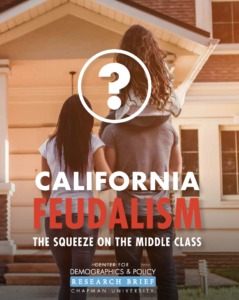 California Feudalism: The Squeeze on The Middle Class
California Feudalism: The Squeeze on The Middle Class
Chapman University, Center for Demographics and Policy
First published October 2018
California was built by people with aspirations, many of them lacking cultural polish or elite educations, but dedicated to hard work, innovation, family, and community. A large number came from other countries or poor backgrounds: sharecroppers from the South, campesinos from Mexico, people fleeing communism and poverty in Asia, escapees from Hitler’s Europe or Okies and others fleeing the dust bowl.
This proud legacy is threatened. California has now taken on an increasingly feudal cast, with a small but growing group of the ultra-rich, a diminishing middle class, and a large, rising segment of the population that is in or near poverty. Indeed, amidst some of the greatest accumulations of wealth in history, California has emerged as a leader in poverty, particularly among its minority and immigrant populations and throughout its interior.
Something is clearly wrong with this picture. Yet our state leaders, and too many of our business and civic leaders, are convinced that California, far from being something of a cautionary tale, offers a great “role model” for the rest of the country. The state’s drift towards an ever more unequal, feudalized society, characterized by concentrated property ownership, persistent poverty levels, and demographic stagnation does not seem to concern our Sacramento leadership.
What needs to change? If we want to again be a place of opportunity for all, we need to dial down California’s increasingly expensive, messianic land use and climate change policies, which have dramatically increased housing and energy costs, forcing individuals and companies elsewhere. This will allow us to develop more housing and middle-class jobs, especially in more affordable areas such as the Central Valley and the Inland Empire. A dramatic reform of our education system, which underserves our next generation, particularly in poor and minority communities, needs to be enacted. Other steps, like investing in basic infrastructure—roads, dams, electric transmission—could boost the flagging blue-collar economy of the state.